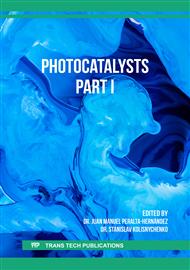[1]
Zhou CY, Ren ZF, Tan SJ, Ma ZB, Mao XC, Dai DX, Fan HJ, Yang XM, LaRue J, Cooper R, Wodtke AM, Wang AM, Wang Z, Li ZY, Wang B, Yang JL, Hou JG. Site-specific photocatalytic splitting of methanol on TiO2 (110). Chemical Science, 2010, 1, 575-580.
DOI: 10.1039/c0sc00316f
Google Scholar
[2]
N.C. Jeong, O.K. Farha, J.T. Hupp, A convenient route to high area, nanoparticulate TiO2 photoelectrodes suitable for high-efficiency energy conversion in dye-sensitized solar cells, Langmuir .27 (2011) 1996–(1999).
DOI: 10.1021/la104297s
Google Scholar
[3]
Zhou, Y.; Zhu, Q.; Tian, J.; Jiang, F. TiO2 nanobelt@Co9S8 composites as promising anode materials for lithium and sodium ion batteries. Nanomaterials.7 (2017) 252–262.
DOI: 10.3390/nano7090252
Google Scholar
[4]
Y.J. Hwang, C. Hahn, B. Liu, P. Yang, Photoelectrochemical properties of TiO2 nanowire arrays: a study of the dependence on length and atomic layer deposition coating, ACS Nano .6 (2012) 5060–5069.
DOI: 10.1021/nn300679d
Google Scholar
[5]
H. Zhang, X. Liu, Y. Li, Q. Sun, Y. Wang, B.J. Wood, P. Liu, D. Yang, H. Zhao, Vertically aligned nanorod-like rutile TiO2 single crystal nanowire bundles with superior electron transport and photoelectrocatalytic properties, Journal of Materials Chemistry .22 (2012) 2465-2472.
DOI: 10.1039/c2jm15546j
Google Scholar
[6]
L. Mancic, R.F.M. Osman, A.M.L.M. Costa, J.R.M. d'Almeida, B.A. Marinkovic, F.C. Rizzo, Mater. Des. 83 (2015) 459–467.
Google Scholar
[7]
Kusior, A.; Kollbek, K.; Kowalski, K.; Borysiewicz, M.; Wojciechowski, T.; Adamczyk, A.; Trenczek-Zajac, A.; Radecka, M.; Zakrzewska, K. Sn and Cu oxide nanoparticles deposited on TiO2 nanoflower 3D substrates by inert gas condensation technique. Appl. Surf. Sci. 380 (2016)193–202.
DOI: 10.1016/j.apsusc.2016.01.204
Google Scholar
[8]
Leary R, Westwood A. Carbonaceous nanomaterials for the enhancement of TiO2 photocatalysis. Carbon, 2011, 49: 741-772.
DOI: 10.1016/j.carbon.2010.10.010
Google Scholar
[9]
Liu C, Daspupta N P, Yang P D. Semiconductor nanowires for artificial Photosynthesis. Chemistry of Materials, 2014, 26(1): 415-422.
Google Scholar
[10]
Feng X, Shankar K, Varghese O K, et al. Vertically aligned single crystal TiO2 nanowire arrays grown directly on transparent conducting oxide coated Glass:synthesis details and applications. Nano Letters, 2008, 8(11): 3781-3786.
DOI: 10.1021/nl802096a
Google Scholar
[11]
Meng S, Ren J, Kaxiras E. Natural dyes adsorbed on TiO2 nanowire for photovoltaic applications: enhanced light absorption and ultrafast electron injection. Nano Letters, 2008, 8(10): 3266-3272.
DOI: 10.1021/nl801644d
Google Scholar
[12]
P. H. Wang, L. G. Yang, L. Z. Wang and J. L. Zhang, Mater. Lett. 164 (2016) 405-408.
Google Scholar
[13]
A. Crisbasan, D. Chaumont, M. Sacilotti, A. M. Lazar, I. Ciobanu, Y. Lacroute and R. Chassagnon, Appl. Surf. Sci. 358 (2015) 655-659.
DOI: 10.1016/j.apsusc.2015.09.113
Google Scholar
[14]
W. zhao, X. J Feng, H. D. Xiao, C. N. Luan and J. Ma, J. Cryst. Growth 453(2016) 106-110.
Google Scholar
[15]
C.L. Wang, W. S. Hwang, H. L. Chu, H. J. Lin, H. H. Ko and M. Chin, Ceram. Int. 42 (2016) 13136-13143.
Google Scholar
[16]
Y. H. Yu, Y. L. Jiang, M. Tian, L. J. Yang, H. J. Yan and S. Sheng, Rare Met. 45(2016) 561-566.
Google Scholar
[17]
Y.N. Zhang, Y. Han and L. Zhang, Thin Solid Films 583 (2015) 151-157.
Google Scholar
[18]
W.Y. Zhou and Y. C. He, Chem. Eng. J. 179 (2012) 412-416.
Google Scholar
[19]
Q.G. He, J. Zhuang, Q. X. Wen, Y. Deng, J. Yu, and H. M. Li, NANO, 11 (2016) 1650066.
Google Scholar
[20]
M. Marandi, M. N. S. Sabet and F. Ahmadloo, B MATER SCI 39 (2016) 1403-1410.
Google Scholar
[21]
S.R. Moulik, A. Ghatak and B. Ghosh, Surf. Sci. 651 (2016) 175-181.
Google Scholar
[22]
B. Ivo, M. Vlastimil and M. J. Josef, Photobiol., A 317 (2016) 72-80.
Google Scholar
[23]
Z.H Liu, X.J Su, G.L Hou, S Bi, Z Xiao, H.P Jia, Hierarchical TiO2 nanorod array for dye-sensitized solar cells, Mater. Lett. 89 (2012) 309–311.
DOI: 10.1016/j.matlet.2012.08.135
Google Scholar



